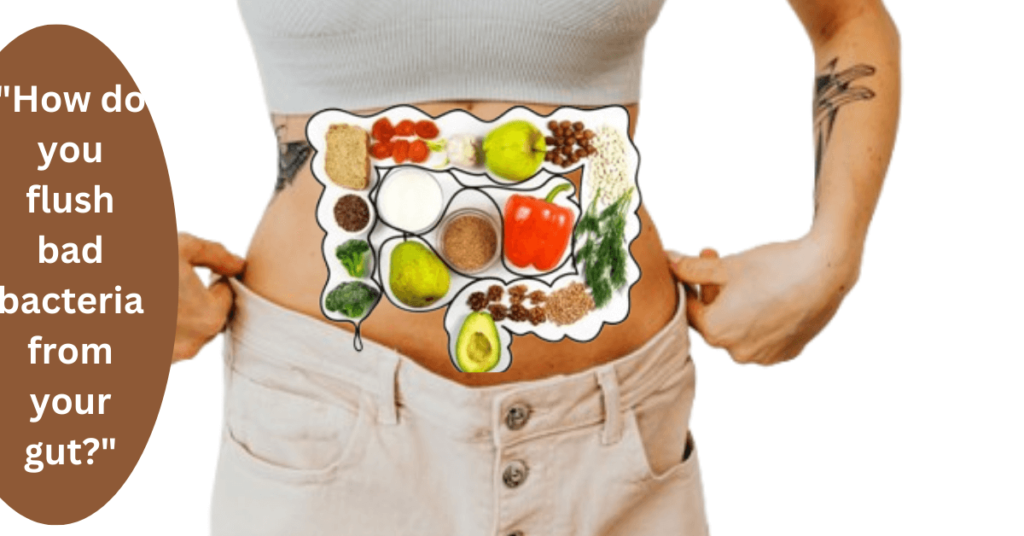“How do you flush bad bacteria from your gut?”. A healthy gut is essential for overall well-being, as it plays a crucial role in digestion, immunity, and even mental health. However, when bad bacteria outnumber good bacteria in your digestive system, it can lead to various problems like bloating, constipation, fatigue, and even more severe conditions like irritable bowel syndrome (IBS). This is where the concept of “flushing bad bacteria from your gut” comes into play. In this article, we will explore effective strategies to eliminate harmful bacteria and restore a balanced gut microbiome.

1. Understanding the Importance of Gut Health
Before diving into how to flush bad bacteria from your gut, it’s essential to understand the importance of maintaining a balanced gut microbiome. Your gut houses trillions of bacteria, some good and some bad. A healthy gut thrives when there is a balance between beneficial bacteria, such as Lactobacillus and Bifidobacterium, and harmful bacteria like Clostridium difficile and Escherichia coli. An imbalance, often caused by poor diet, stress, or the overuse of antibiotics, can disrupt this delicate ecosystem, leading to digestive issues and health problems.
2. How Do You Flush Bad Bacteria from Your Gut Naturally?
Flushing bad bacteria from your gut involves strategies to support your body’s natural detoxification processes. Here are some effective ways to do so:
A. Incorporate Probiotics and Prebiotics into Your Diet
One of the most natural and effective ways to flush bad bacteria from your gut is by introducing more probiotics and prebiotics into your diet. Probiotics are live beneficial bacteria that help restore the balance in your gut microbiome. Foods rich in probiotics include yogurt, kefir, sauerkraut, kimchi, miso, and kombucha. These foods help replenish the good bacteria and crowd out harmful ones.
Prebiotics, on the other hand, are non-digestible fibers found in foods like garlic, onions, bananas, and whole grains. These fibers act as food for the beneficial bacteria in your gut, helping them thrive. By eating both probiotics and prebiotics, you can create an environment in your gut that makes it difficult for bad bacteria to thrive.
B. Drink Plenty of Water
Flushing bad bacteria from your gut requires proper hydration. Water helps in the digestion process and assists in the removal of waste products and toxins from your body. Staying hydrated also supports the mucosal lining in the intestines, which plays a critical role in protecting your gut from harmful bacteria.
Aim to drink at least 8 glasses of water per day to keep your digestive system running smoothly. If you’re trying to flush bad bacteria, consider adding lemon to your water, as it has natural antibacterial properties and can help stimulate the digestive system.
C. Consume Antibiotic Foods and Herbs
Certain foods and herbs have natural antibiotic properties that can help target and flush bad bacteria from your gut. These foods include garlic, ginger, turmeric, and oregano. Garlic, for example, has allicin, a compound that has been shown to kill harmful bacteria while promoting the growth of beneficial bacteria. Ginger and turmeric have anti-inflammatory and antibacterial properties, helping reduce gut irritation and imbalance caused by bad bacteria.
Incorporating these herbs and spices into your diet regularly can help support your body’s ability to flush out bad bacteria naturally. For example, try adding garlic to your cooking, drinking ginger tea, or adding turmeric to smoothies and curries.
D. Eat Fiber-Rich Foods
Dietary fiber plays an essential role in promoting gut health and flushing bad bacteria from your system. Fiber-rich foods like fruits, vegetables, legumes, and whole grains provide the necessary bulk to your stool, promoting regular bowel movements and preventing constipation. Fiber also helps nourish the good bacteria in your gut while supporting the elimination of waste and toxins.
To improve gut health, aim for a variety of fiber-rich foods, including leafy greens, berries, oats, beans, and lentils. These foods will not only help flush bad bacteria from your gut but will also promote healthy digestion and a well-balanced microbiome.
E. Consider Digestive Enzymes and Supplements
Digestive enzymes help break down food more efficiently, supporting your body’s natural detoxification processes. By ensuring your body can absorb nutrients more effectively, digestive enzymes help reduce the load on your gut, making it easier to flush out harmful bacteria. You can find digestive enzyme supplements in health food stores, or you can boost enzyme production by eating pineapple (which contains bromelain) and papaya (which contains papain).
Additionally, certain supplements like activated charcoal and bentonite clay may help bind to and eliminate harmful bacteria and toxins from your digestive tract. However, it’s important to consult a healthcare provider before using supplements, as some may interact with medications or have adverse effects.
3. The Role of Healthy Fats in Flushing Bad Bacteria
Healthy fats, such as those found in avocados, olive oil, and fatty fish like salmon, are essential for gut health. These fats have anti-inflammatory properties and support the integrity of the gut lining. They also help balance the gut microbiome by providing nourishment to the beneficial bacteria.
Omega-3 fatty acids, in particular, can help reduce gut inflammation caused by an overgrowth of bad bacteria. To flush bad bacteria from your gut, include more healthy fats in your diet by using olive oil in your cooking, adding avocado to salads, and eating fatty fish like mackerel and sardines.
4. How Do You Flush Bad Bacteria from Your Gut with Detox Programs?
Some individuals choose to undergo gut detox programs to speed up the process of flushing bad bacteria from their system. These detox programs often include fasting, juice cleanses, or special diets aimed at resetting the gut. While some detox programs may provide short-term benefits, it’s important to approach them with caution and under the guidance of a healthcare professional.
A well-structured gut detox program typically involves consuming a diet rich in whole, organic foods, eliminating processed foods, and reducing sugar intake, which can feed bad bacteria. Many detox programs also recommend adding anti-inflammatory herbs and supplements, such as those mentioned above, to support gut health.
5. The Importance of Reducing Stress to Flush Bad Bacteria
Chronic stress has been shown to disrupt the balance of bacteria in the gut, promoting the growth of harmful bacteria. To flush bad bacteria from your gut effectively, it’s crucial to manage stress levels. Regular stress management practices, such as meditation, deep breathing exercises, yoga, and physical exercise, can help balance the gut microbiome and support overall health.
Stress reduction techniques not only help calm the mind but also promote better digestion and a more balanced gut. Aim to incorporate stress-reducing practices into your daily routine to support your gut health long-term.
6. Conclusion: Flushing Bad Bacteria from Your Gut for Better Health
Flushing bad bacteria from your gut is a multifaceted process that requires a holistic approach to diet, hydration, stress management, and lifestyle choices. By incorporating probiotic-rich foods, fiber, and natural antibiotics into your diet, staying hydrated, managing stress, and considering digestive supplements, you can restore balance to your gut microbiome. Remember, a healthy gut is key to maintaining overall wellness, and by taking proactive steps, you can effectively flush bad bacteria and improve your digestive health.
In summary, how do you flush bad bacteria from your gut? Through a combination of diet, hydration, and mindful lifestyle choices, you can support your body’s natural ability to eliminate harmful bacteria and restore balance for improved digestive and overall health.

